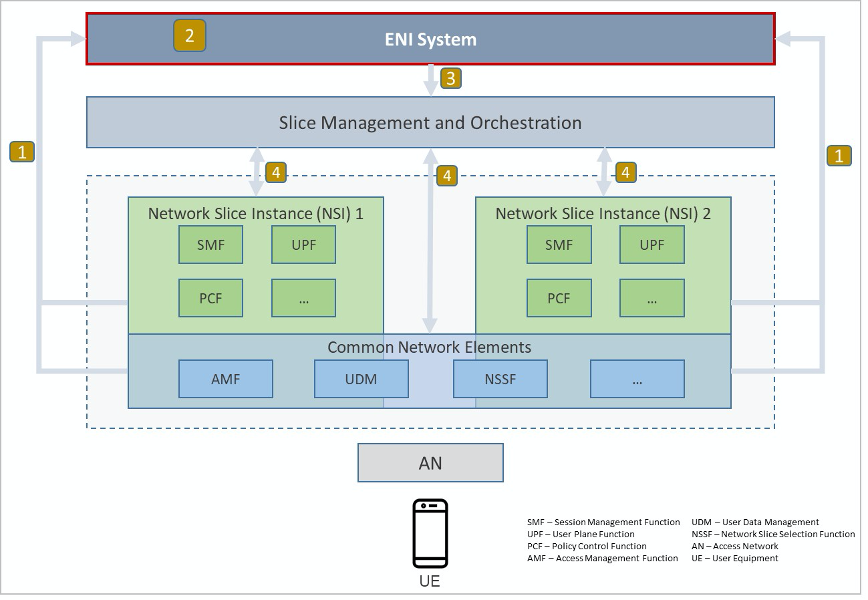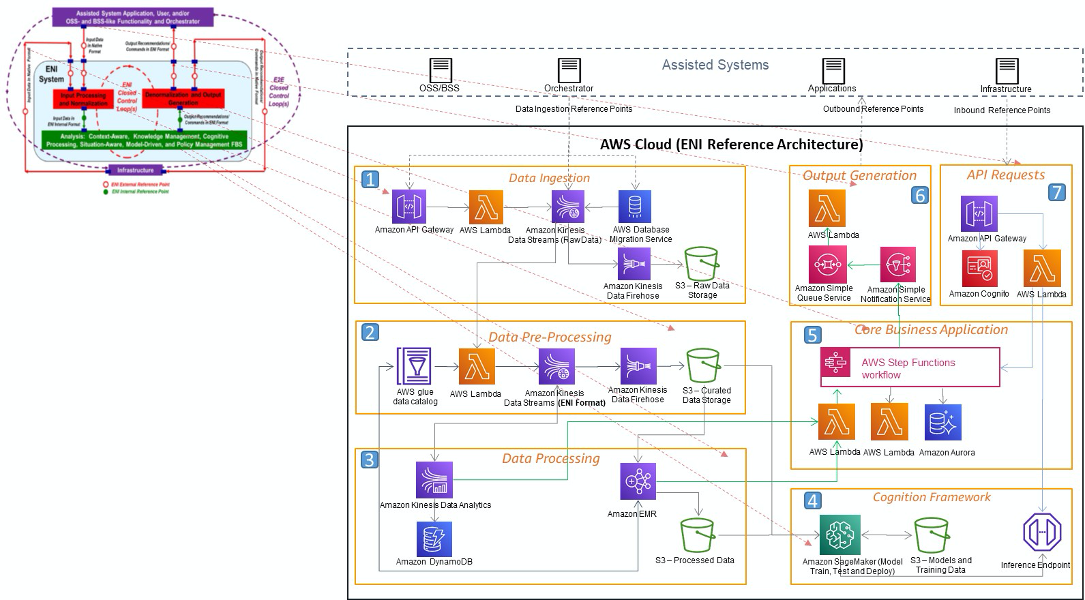AWS for Industries
Intelligent Network Slicing on AWS using ETSI ENI
Introduction
5G brings a range of new opportunities for telecom operators to provide personalized solutions that meet specific customer requirements. Through a combination of increased bandwidth, virtualized and software-oriented network capabilities, 5G enables the network slicing capability where a single physical infrastructure can be split into multiple network slices. Though network slices share common infrastructure, each slice offers a self-contained logical network with different capabilities (such as latency, bandwidth, and reliability) based on the use case and user needs.
ETSI ENI (Experiential Networked Intelligence) initiative defines standards for cognitive network management and helps the implementation of 5G use cases based on environmental context and user requirements.
This blog post shows how ETSI ENI based architectures can be implemented on AWS by utilizing services from different domains. It introduces a reference architecture that maps ETSI ENI’s functional components into specific AWS services and explains the data flows between those components with a sample ENI use case.
Overview
5G use cases primarily fall under three categories:
- Massive machine-type communications (mMTC): These applications contain a large number of devices, but they consume low bandwidth, for example, Internet of Things (IoT)
- Ultra-reliable low-latency communications (urLLC): These applications have very low latency and high reliability requirements, for example, vehicle-to-X
- Enhanced mobile broadband (eMBB): These are bandwidth-intensive applications that generate significant network traffic, for example, video streaming
As per 3GPP standards (defined in 3GPP TS 23.501 V1.4.0 [3]), network slices are realized through network slice instances (NSIs). Each NSI is a grouping of logical network functions across access, transport, and core network domains to provide required end-to-end service. In the initial stage, there may be few NSIs and can be handled manually. But as the number of NSIs increases, managing them manually will become complicated. Additionally, for more advanced use cases, new NSI requirements such as dynamic instantiation and runtime policy changes are emerging.
The solution needed to implement these requirements requires real-time holistic information about the network and artificial intelligence (AI) capabilities that can configure context-aware policies based on service requirements and network conditions.
ETSI’s ENI provides a standardized approach for intelligently managing these NSIs in the closed-loop system. Implementation of ENI architecture enables the automation and AI algorithms to dynamically configure NSIs in a scalable and flexible manner.
Figure 1 demonstrates the interaction between ENI and external network systems.
- Network elements from each NSI send network data to the ENI system. Network data may include network triggers, slice utilization data, usage patterns, and other parameters.
- The ENI system then compares data received from network elements with the reference metadata to determine the current health of each network slice. The ENI system also runs analytics or ML algorithms to develop recommendations for NSIs.
- ENI system then sends these recommendations to the slice management and orchestration function.
- The slice management and orchestration function implements these recommendations on each NSI.

Figure 1: ENI Network Slice Management and Orchestration
AWS Reference Architecture for ENI
Figure 2 shows the ETSI-defined functional ENI architecture (source: ETSI) that helps automate complex semi-manual decision-making network resource management processes. It enables multiple use cases by dynamically changing network configuration based on received contextual data, service SLAs, and changing user requirements.

Figure 2: ENI High-Level Functional Architecture
ETSI ENI defined functional architecture can be enabled using the broadest and deepest set of cloud computing capabilities provided by AWS. Using AWS, customers can quickly implement ENI capabilities at global scale in an agile, scalable, cost-efficient manner.

Figure 3: AWS Reference Architecture for ENI
AWS reference architecture can enable multiple ENI use cases. In this blog, we will focus on how intelligent network slicing can be implemented by explaining the dataflow between the relevant architectural components.
AWS Solution for ENI based Intelligent Network Slicing Use Case
Realization of AWS ENI reference architecture for intelligent network slicing use case can be seen in the following diagram.

Figure 4: Data Flow Diagram for Intelligent Network Slicing
- Data Ingestion
ENI gathers contextual information from multiple sources in different formats and frequencies. At this stage, several AWS components can be used, depending on the format and nature of the input data.
-
- Amazon Kinesis Data Streams receives streaming information from different network elements of NSIs. Streaming information can include traffic patterns, packet loss rate, and users’ behavior and location.
- Amazon API Gateway and AWS Lambda capture network triggers and events in real-time. These could include resource utilization, network KPIs, and network faults.
- AWS Database Migration Service (AWS DMS) captures any changes to metadata or policies stored in relational databases. This may include slice topology and configuration, desired service SLAs, and network KPIs.
Raw data from all these sources is consolidated in Amazon Kinesis Data Streams and is also stored in Amazon S3 object storage using Amazon Kinesis Data Firehose.
- Data Pre-Processing
In the data preprocessing phase, previously collected raw data on the Kinesis data stream is converted to an ENI-defined format. An AWS Lambda function is used to do the conversion based on the ENI schema stored in AWS Glue Data Catalog. This ENI formatted data is saved in another stream in Amazon Kinesis Data Streams and also written to a separate S3 bucket that will further be used for analytics and ML model training.
- Data Processing
In the data processing phase, Amazon Kinesis Data Analytics performs real-time analytics on the ENI-formatted stream to detect any anomalies. It applies business logic to incoming data and performs analysis against the reference data to determine if any actions need to be triggered for NSI reconfiguration.
In addition to real-time analytics, Amazon EMR performs big data processing to prepare the data for training ML models. It acts on the formatted data stored in an S3 bucket and aggregates, filters, and cleanses it before storing it in another S3 bucket. (Processed data)
- Cognition Framework
Intelligent network slice management strategy can be developed by applying machine learning (ML) to predict usage patterns, resource contentions, and developments. Amazon SageMaker is a managed service to train, test, and deploy ML models. Amazon SageMaker comes with multiple inbuilt algorithms such as
-
- XGBoost (eXtreme Gradient Boosting) to help forecast resource utilization trends.
- K-Means can cluster similar types of devices and services based on multiple parameters. Policies for each cluster can be configured as a group based on specific SLAs, frequency, and so on.
- Principal component analysis (PCA) to reduce the data dimensionality and help classify data or detect anomalies.
If you have an existing model, Amazon SageMaker also allows you to bring your own model. Once the model is trained, you can use Amazon SageMaker to generate inferences through the use of Rest APIs.
- Core Business Logic
There will be cases that need workflows which aggregate multiple steps required to develop recommendations or issue commands to slice management and orchestration. AWS Step Functions is a low-code visual workflow service used to orchestrate AWS services, automate business processes, and build serverless applications.
It contains business logic to take appropriate actions based on triggered events, predefined policies, service and network current context, and ML inferences. Workflow may also include negotiations across multiple entities and services to avoid resource contention and to allocate resources based on parameters such as service criticality, SLAs, and so on .
- Output Generation
Output Generation module transforms the data from ENI to consumer compatible format. Once a recommendation or command arrives in Amazon Simple Notification Service (Amazon SNS), it is pushed to Amazon Simple Queue Service (Amazon SQS). This pattern ensures loose coupling between the core ENI platform and the output generation module. Before sending the output to the slice management and orchestration function, AWS Lambda transforms it to the consumer-desired format.
Conclusion
In this blog, we showed how ETSI ENI based architectures can be realized on AWS by defining a reference architecture that maps several ENI functional components to AWS services. We also showed how this reference architecture can be utilized to implement an intelligent network slicing use case.
AWS Cloud allows communications service providers (CSPs) to experiment, develop, and deploy ETSI ENI compliant systems that are realizing one or more 5G use cases.
You can find more information on ETSI ENI at the . You can also visit Telecommunications on AWS to learn about how CSPs reinvent communication with AWS.